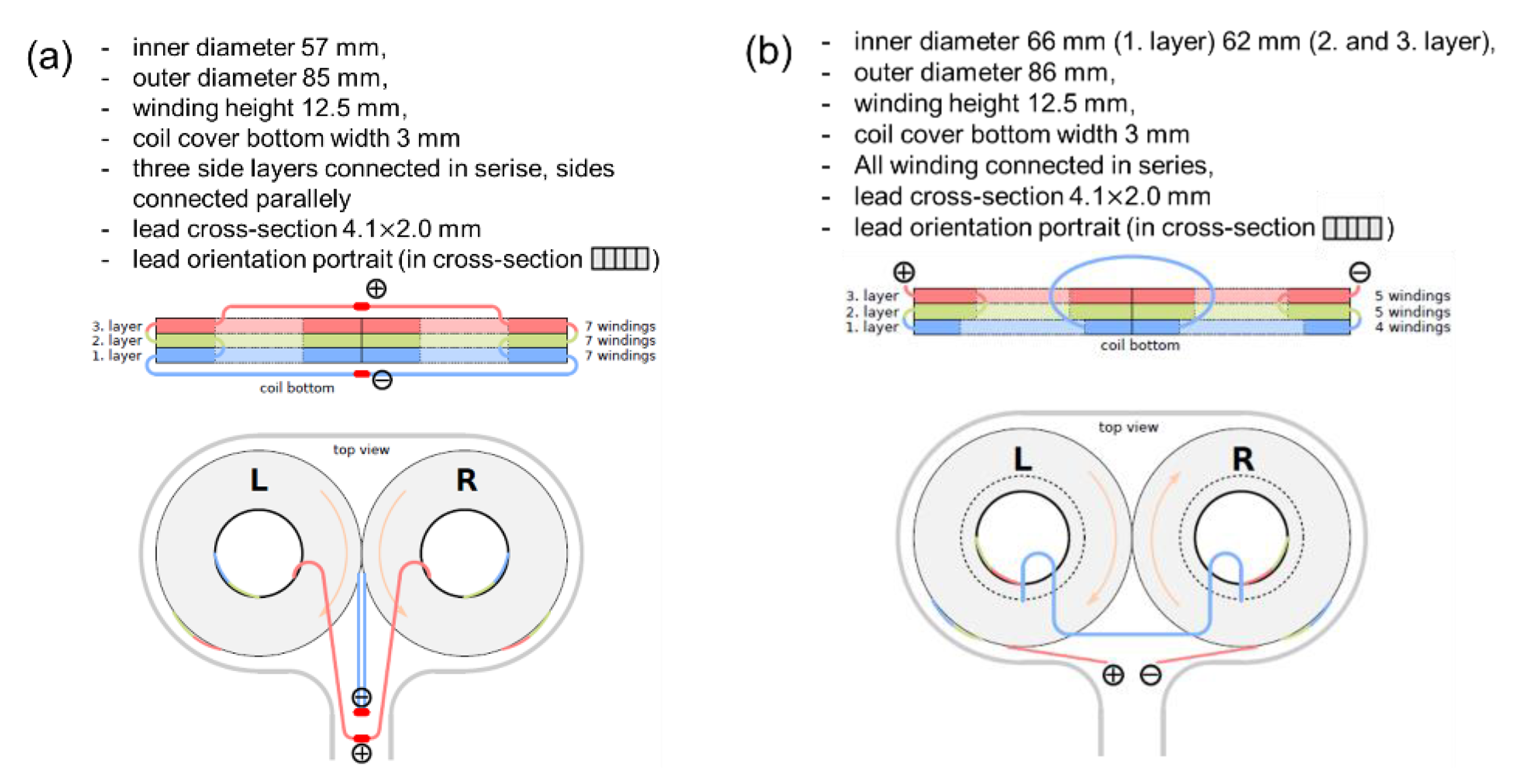Development of an Advanced Sham Coil for Transcranial Magnetic Stimulation and Examination of Its Specifications
Abstract
:1. Introduction
2. Materials and Methods
2.1. Structure of Active and Sham Coils and Characteristics of Monophasic Waveforms Induced by These Coils
2.2. Comparison of Magnetic Flux Changes for Each Coil
2.3. Temperature Changes Associated with the Accumulation of TMS Pulses in Each Coil
2.4. Measurements of Coil Click Sound Pressure with Change of Stimulus Intensity
3. Results
3.1. Monophasic Waveforms of the Active and Sham Coils
3.2. Comparison of Magnetic Flux Changes in Each Coil
3.3. Coil Temperature Changes with Continuous Use of TMS
3.4. Comparison of the Click Sound Pressure Generated by the Active and Sham Coils during Stimulation
4. Discussion
4.1. Characteristics of Sham Coil
4.2. TMS-EEG Study Using Sham Condition
4.3. Solutions to the above Problems and Limitations with the New Sham Coil
4.4. Future Direction
4.5. Limitations of the Present Sham Coil
5. Conclusions
Author Contributions
Funding
Institutional Review Board Statement
Informed Consent Statement
Data Availability Statement
Acknowledgments
Conflicts of Interest
References
- Fuggetta, G.; Fiaschi, A.; Manganotti, P. Modulation of cortical oscillatory activities induced by varying single-pulse transcranial magnetic stimulation intensity over the left primary motor area: A combined EEG and TMS study. NeuroImage 2005, 27, 896–908. [Google Scholar] [CrossRef] [PubMed]
- Du, X.; Choa, F.-S.; Summerfelt, A.; Rowland, L.M.; Chiappelli, J.; Kochunov, P.; Hong, L.E. N100 as a Generic Cortical Electrophysiological Marker Based on Decomposition of TMS-Evoked Potentials across Five Anatomic Locations. Exp. Brain Res. 2017, 235, 69–81. [Google Scholar] [CrossRef] [PubMed] [Green Version]
- Herring, J.D.; Thut, G.; Jensen, O.; Bergmann, T.O. Attention Modulates TMS-Locked Alpha Oscillations in the Visual Cortex. J. Neurosci. 2015, 35, 14435–14447. [Google Scholar] [CrossRef] [PubMed] [Green Version]
- Gordon, P.C.; Desideri, D.; Belardinelli, P.; Zrenner, C.; Ziemann, U. Comparison of cortical EEG responses to realistic sham versus real TMS of human motor cortex. Brain Stimul. 2018, 11, 4–18. [Google Scholar] [CrossRef] [PubMed]
- Conde, V.; Tomasevic, L.; Akopian, I.; Stanek, K.; Saturnino, G.B.; Thielscher, A.; Bergmann, T.O.; Siebner, H.R. The non-transcranial TMS-evoked potential is an inherent source of ambiguity in TMS-EEG studies. NeuroImage 2019, 185, 300–312. [Google Scholar] [CrossRef]
- Rocchi, L.; Di Santo, A.; Brown, K.; Ibáñez, J.; Casula, E.; Rawji, V.; Di Lazzaro, V.; Koch, G.; Rothwell, J. Disentangling EEG responses to TMS due to cortical and peripheral activations. Brain Stimul. 2020, 13, 1040–1050. [Google Scholar] [CrossRef]
- Rossi, S.; Ferro, M.; Cincotta, M.; Ulivelli, M.; Bartalini, S.; Miniussi, C.; Giovannelli, F.; Passero, S. A real electro-magnetic placebo (REMP) device for sham transcranial magnetic stimulation (TMS). Clin. Neurophysiol. 2007, 118, 709–716. [Google Scholar] [CrossRef] [PubMed] [Green Version]
- Smith, J.E.; Peterchev, A.V. Electric field measurement of two commercial active/sham coils for transcranial magnetic stimulation. J. Neural Eng. 2018, 15, 054001. [Google Scholar] [CrossRef] [PubMed]
- Deng, Z.-D.; Lisanby, S.H.; Peterchev, A.V. Electric field depth–focality tradeoff in transcranial magnetic stimulation: Simulation comparison of 50 coil designs. Brain Stimul. 2013, 6, 1–13. [Google Scholar] [CrossRef] [PubMed] [Green Version]
- Wagner, T.A.; Zahn, M.; Grodzinsky, A.J.; Pascual-Leone, A. Three-Dimensional Head Model Simulation of Transcranial Magnetic Stimulation. IEEE Trans. Biomed. Eng. 2004, 51, 1586–1598. [Google Scholar] [CrossRef] [PubMed]
- Koponen, L.; Goetz, S.M.; Tucci, D.L.; Peterchev, A.V. Sound comparison of seven TMS coils at matched stimulation strength. Brain Stimul. 2020, 13, 873–880. [Google Scholar] [CrossRef] [PubMed]
- Ter Braack, E.M.; de Vos, C.C.; van Putten, M.J.A.M. Masking the Auditory Evoked Potential in TMS-EEG: A Comparison of Various Methods. Brain Topogr. 2015, 28, 520–528. [Google Scholar] [CrossRef] [PubMed]







Publisher’s Note: MDPI stays neutral with regard to jurisdictional claims in published maps and institutional affiliations. |
© 2021 by the authors. Licensee MDPI, Basel, Switzerland. This article is an open access article distributed under the terms and conditions of the Creative Commons Attribution (CC BY) license (https://creativecommons.org/licenses/by/4.0/).
Share and Cite
Takano, M.; Havlicek, J.; Phillips, D.; Nakajima, S.; Mimura, M.; Noda, Y. Development of an Advanced Sham Coil for Transcranial Magnetic Stimulation and Examination of Its Specifications. J. Pers. Med. 2021, 11, 1058. https://doi.org/10.3390/jpm11111058
Takano M, Havlicek J, Phillips D, Nakajima S, Mimura M, Noda Y. Development of an Advanced Sham Coil for Transcranial Magnetic Stimulation and Examination of Its Specifications. Journal of Personalized Medicine. 2021; 11(11):1058. https://doi.org/10.3390/jpm11111058
Chicago/Turabian StyleTakano, Mayuko, Jiri Havlicek, Dan Phillips, Shinichiro Nakajima, Masaru Mimura, and Yoshihiro Noda. 2021. "Development of an Advanced Sham Coil for Transcranial Magnetic Stimulation and Examination of Its Specifications" Journal of Personalized Medicine 11, no. 11: 1058. https://doi.org/10.3390/jpm11111058
APA StyleTakano, M., Havlicek, J., Phillips, D., Nakajima, S., Mimura, M., & Noda, Y. (2021). Development of an Advanced Sham Coil for Transcranial Magnetic Stimulation and Examination of Its Specifications. Journal of Personalized Medicine, 11(11), 1058. https://doi.org/10.3390/jpm11111058






